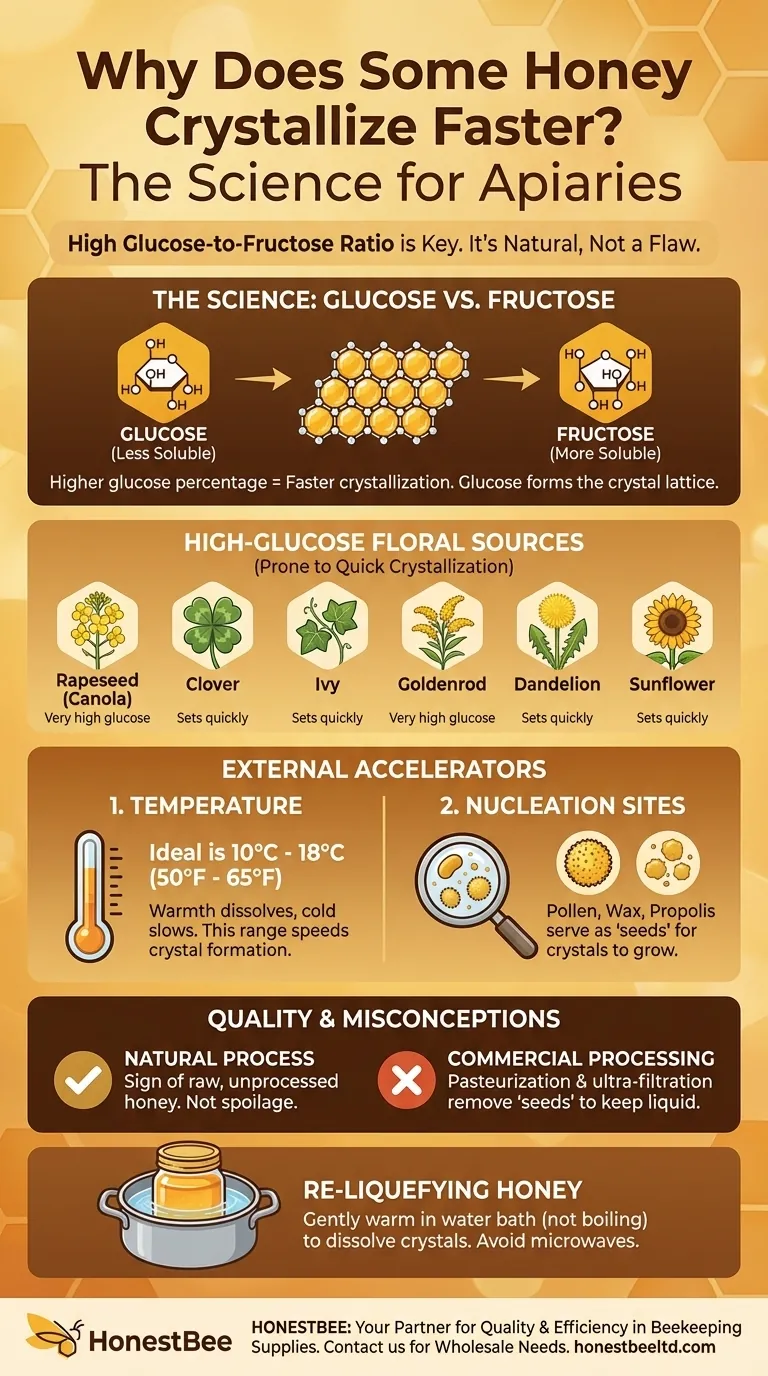In short, honey derived from floral nectars with a higher glucose-to-fructose ratio will crystallize more quickly. Key examples include honey from rapeseed (canola), clover, ivy, and goldenrod. The high concentration of glucose in these nectars encourages the formation of sugar crystals, often within weeks or months of being harvested.
Honey crystallization is not a flaw but a natural process driven by the nectar's specific sugar profile. Floral sources high in glucose will always crystallize faster than those high in fructose, and this tendency is a sign of raw, natural honey, not spoilage.

The Science Behind Crystallization: Glucose vs. Fructose
Honey is a supersaturated solution, meaning it contains more sugar than can normally remain dissolved in its water content. This delicate balance is easily disturbed, leading to crystallization.
The Role of Sugar Ratios
The two primary sugars in honey are glucose and fructose. The ratio between these two sugars is the single most important factor determining how fast honey will crystallize.
Glucose has a much lower solubility in water than fructose. Therefore, honey with a higher percentage of glucose will be less stable and will crystallize more rapidly.
How Glucose Forms Crystals
Think of the glucose molecules as the primary building blocks for crystals. In a high-glucose honey, these molecules begin to separate from the water and arrange themselves into an orderly lattice.
This process solidifies the honey, turning it from a liquid into a semi-solid state. The fructose, being more soluble, tends to remain liquid around the glucose crystals.
Common High-Glucose Floral Sources
The nectar composition of the flower directly dictates the honey's sugar ratio. Beekeepers know that certain floral sources reliably produce honey that crystallizes fast.
These sources include:
- Rapeseed (Canola)
- Clover
- Goldenrod
- Ivy
- Dandelion
- Sunflower
External Factors That Accelerate Crystallization
While the floral source sets the potential for crystallization, other conditions can speed up the process.
The Influence of Temperature
Temperature plays a critical role. The ideal range for rapid crystallization is between 10°C and 18°C (50°F and 65°F).
Storing honey in a cool pantry or cabinet often puts it right in this zone. Colder temperatures (like in a refrigerator) significantly slow the process because the honey becomes too viscous for crystals to form, while warmer temperatures keep the glucose dissolved.
The Impact of Pollen and Wax
Raw, unfiltered honey contains microscopic particles of pollen, beeswax, and propolis. These particles act as nucleation sites.
Crystals need a starting point to begin forming. Each tiny grain of pollen can serve as a seed for a sugar crystal to grow, which is why raw honey often crystallizes faster and more uniformly than highly filtered honey.
Understanding the Trade-offs: Is Crystallized Honey Bad?
A common misconception is that crystallized honey has gone bad. The opposite is often true.
A Mark of Quality, Not Spoilage
Crystallization is a natural process and a hallmark of raw, unprocessed honey. It confirms that the honey has not been overheated or filtered to the point of removing all its natural components, including beneficial pollen.
Why Commercial Honey Stays Liquid
Many mass-market honeys are pasteurized (heated to high temperatures) and ultra-filtered. This processing destroys crystal "seeds" like pollen and melts any existing micro-crystals to ensure the product remains visually appealing and liquid on the shelf for longer.
How to Re-liquefy Your Honey
If you prefer your honey in a liquid state, the process is simple. Place your glass jar of honey in a pot of warm (not boiling) water and stir it gently until the crystals dissolve. Avoid using a microwave, as it can easily overheat the honey and degrade its delicate flavors and beneficial enzymes.
Making the Right Choice for Your Goal
Your preference for honey's texture should guide your choices.
- If your primary focus is a spreadable, creamy texture: Seek out honey from high-glucose sources like clover or canola, as their rapid crystallization creates a desirable, fine-grained product often marketed as "creamed" or "spun" honey.
- If your primary focus is a long-lasting liquid honey: Choose honey from high-fructose sources known to resist crystallization for years, such as Acacia, Tupelo, or Sage honey.
- If your raw honey has already crystallized: Simply warm it gently in a water bath to return it to a liquid state without damaging its natural properties.
Ultimately, understanding crystallization allows you to appreciate honey not as a uniform product, but as a dynamic reflection of its natural origin.
Summary Table:
| Fast-Crystallizing Honey Sources | Key Characteristic |
|---|---|
| Rapeseed (Canola) | Very high glucose content |
| Clover | High glucose-to-fructose ratio |
| Ivy | Prone to rapid crystallization |
| Goldenrod | Sets quickly, often within weeks |
| Dandelion | Known for fast granulation |
| Sunflower | High glucose, crystallizes rapidly |
For commercial apiaries and beekeeping equipment distributors: Ensure your operation is equipped to handle and process all types of honey, including fast-crystallizing varieties. HONESTBEE supplies the durable, high-quality beekeeping supplies and extraction equipment you need to maximize efficiency and honey quality. Contact our wholesale team today to discuss your specific needs and discover how our products can support your success.
Visual Guide

Related Products
- Stainless Steel Honey Press Wax Press with Tank
- Honey Wax Separating Wax Press with Metal Screw Wax Separator Machine
- Easy Use Manual Stainless Steel Honey Press for Honey Comb
- 10L Stainless Steel Electric Honey Press Machine
- Economy Honey Homogenizer Mixer and Melting Machine for Beekeeping
People Also Ask
- What happens to the wax after pressing in a honey press? A Guide to Maximizing Your Hive's Yield
- How does the press method for extracting honey work? A Simple, Low-Cost Guide for Beekeepers
- What are the main differences between centrifugal extractors and honey presses? A Guide for Commercial Apiaries
- What are the uses of honey in various industries? Unlock Its Functional Power in Food, Pharma & Cosmetics
- How was the honey press cleaned after use? Quick vs. Deep Cleaning Methods Explained



















